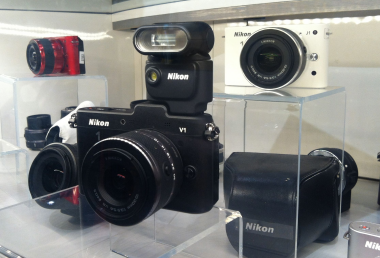Three Cameras in Focus at CES
from All Things Digital by Lauren GoodeSmartphones are munching at many industries, including cameras. And while some camera makers are looking to compete by making their digital cameras “smarter” — which means adding more Wi-Fi capabilities and apps — others are focusing on their core capabilities: Taking pictures. Here are three cameras that stood out at the Consumer Electronics Show last week:
Canon PowerShot G1 X
The Canon PowerShot G1 X follows the PowerShot G12, which will stay in Canon’s product lineup; the G1 X adds the largest sensor to date for a Canon PowerShot model. Bodywise, it’s not as chunky as a DSLR, but it’s larger than the PowerShot G12, and still has a pretty solid composite-material body, weighing in at 19 ounces and measuring 4.98 x 2.93 x 2.12 inches.

The camera uses a 1.5-inch, 14.3 megapixel high-sensitivity CMOS sensor, which is 6.3 times larger than the G12’s sensor. A representative for Canon says it works especially well in low light.
Interchangeable lenses aren’t an option — the G1 X does have a 28mm-to-112mm (4x) optical zoom lens — and for hobbyists, this will be just fine. But for fans of the Canon 5D, 7D, and 60D, the lack of lens options could be what makes them stay true to their DSLRs.
The G1 X also captures 1080p HD video, with optical zooming and auto-focus features. It’s got a pop-up flash, and a fully rotating view screen. While some consumers might prefer not to have an extra view-screen “arm” hanging off the camera, regular video shooters might prefer this to an embedded view screen.
The Canon G1 X will cost $799, and is expected to hit the market at the end of February.
FujiFilm X-Pro 1
Fujifilm’s new flagship product will stoke the fires of your inner photo freak, but will likely leave a big, gaping hole in your wallet.
Fujifilm is touting a brand-new proprietary sensor that is supposed to set this device apart from other cameras. In fact, the new sensor is establishing the X-Pro 1 as the new flagship camera of Fujifilm. The X-Pro 1 has a 16.3 megapixel CMOS sensor, sized 23.6 mm x 15.6 mm. Fujifilm says this new sensor allows for the removal of additional low-pass filters within the camera, and still captures high-resolution images and true colors.

The X-Pro 1 supports three interchangeable lenses, captures 1080p HD video, and has a hybrid multi-iew finder that switches between electronic and optical view.
The body of the camera has a vintage look, which camera buffs will appreciate, and it’s palpably heavier than Fujifilm’s X100 camera.
With the X-Pro 1, Fujifilm is targeting an advanced photographer, and likely one that is focused on taking still images, rather than video. The price point hasn’t been set yet, but it will likely retail for more than the FinePix X100, which retails for $1,200. Fujifilm is aiming for a March 2012 launch of the X-Pro 1.
Nikon 1 Series
The belle of the CES ball this year was Nikon’s D4 camera, which won various awards throughout the week. But the D4 is geared toward professionals — and costs $6,000.
For consumers, the Nikon “1″ series cameras may be the way to go. These cameras actually hit the market last October, but were still getting attention at last week’s big show in Las Vegas.

The Nikon 1 V1, at $849, is slightly bigger than the J1, and has an electronic viewfinder and one other feature that I feel is a real bonus. Otherwise, the V1 and J1 are almost identical. The 1 series cameras are not full-fledged DLSRs, but offer some of the same advanced functionality, and support interchangeable lenses. They pack in a 10.1 megapixel, 13.2 mm x 8.8 mm high-speed AF CMOS sensor, and have a 2.7x lens focal length. Like many digital cameras on the market, they capture 1080p HD video.
There’s one dial on the back for toggling between the four functions of the camera: Still images, video, motion snapshot and smart photo selection. For some users, this makes the V1 and J1 simpler to navigate than other compact cameras; others might not like some of the limits on customization. Bounce-flash accessories, like the SB-N5 speedlight for the V1, are available for purchase, and offer a bit more illumination than built-in pop-up lights.
But there’s one small feature on the Nikon 1 V1 that makes a big difference, in my opinion — the external audio input. Very few point-and-shoots or DSLRs come with a microphone jack; in order to capture good, isolated sound on many cameras, you’d have to slide an accessory into the “hot shoe” at the top of the camera. With the Nikon 1 V1, you could attach a stereo mic and stop apologizing for the bad audio and ambient noise in your videos.
The Nikon 1 V1 retails for $849; the Nikon 1 J1 costs $699.
No comments:
Post a Comment